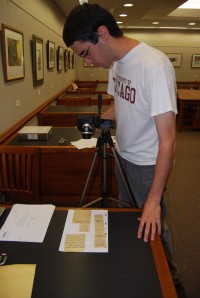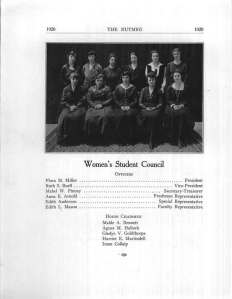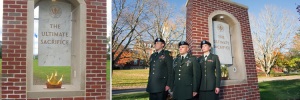We have posted frequently about the collections, events and activities surrounding Archives & Special Collections in this blog. Today I’d like to do something a little different and share an example of the research being conducted in the reading room this spring. Olivier Burtin, a graduate student from France and Strochlitz Travel Grant awardee, made a second trip to Storrs in March to continue his research in the Vivien Kellems papers.

Olivier Burtin, a Strochlitz Travel grant awardee, conducting research in the reading room.
A comment about his research from Olivier:
The research I am conducting on Vivien Kellems is the product of my broader interest in U.S modern history, and more specifically in the history of U.S conservatism. I started to delve into the subject early in 2010 for my Master’s Degree thesis at Sciences Po in Paris. Since then, I have made two trips to the Thomas J. Dodd Research Center at the University of Connecticut, Storrs, where Kellems’ personal papers are located. There are a number of reasons why I decided to study this topic.
A successful Connecticut businesswoman, Kellems (1896-1975) founded and operated her own cable grips company for more than thirty years, at a time when managerial positions were overwhelmingly male-dominated. She was also a highly controversial public figure known primarily for her unorthodox opposition to income taxation, beginning in World War II. Her political involvement combined staunch anti-tax resistance (leading to several suits against the federal state), fierce conservative criticism of government and unwavering advocacy of women’s rights, all put forward by unique oratorical and public relations skills that made her famous nationwide. She acted as a prominent maverick in Connecticut politics, running several times for Congress from 1942 to 1962. Although she remains a lingering presence today in the memory of many conservatives and residents of this state, her personal papers – donated to the University by her nephew in 1992 – have yet to be thoroughly investigated by historians.
Kellems’ life is not only fascinating in itself, it is also a valuable addition to the growing literature on U.S conservatism and it helps us understand its historical development. Her career spanned a critical time in America when liberalism was flourishing; hence it offers an insight into the relatively under-documented origins of the conservative renewal in the 1940s and 1950s. Although she ultimately failed to create a perennial political movement around her, she gathered more than 10,000 sympathizers in the early 1950s with her national women’s organization, the Liberty Belles. Years later, she played a central role as a standard bearer of tax resistance in the late 1960s and early 1970s, with her struggle against unfair income taxation for singles. Her papers contain a wide variety of sources – political fan letters, membership lists, newspapers clippings, etc. – that allow me to document not only her career but also the growth of a political movement.
She passed away in 1975 as active as ever: she had just resumed her PhD a few years earlier at the University of Edinburgh and was about to submit her doctoral dissertation…on taxation, of course!
Mr. Burtin is one of several travel grant awardees who have come to Storrs this year to conduct research in the collections. Over time, I hope to share more of their interests and stories with you.
Betsy Pittman, University Archivist















